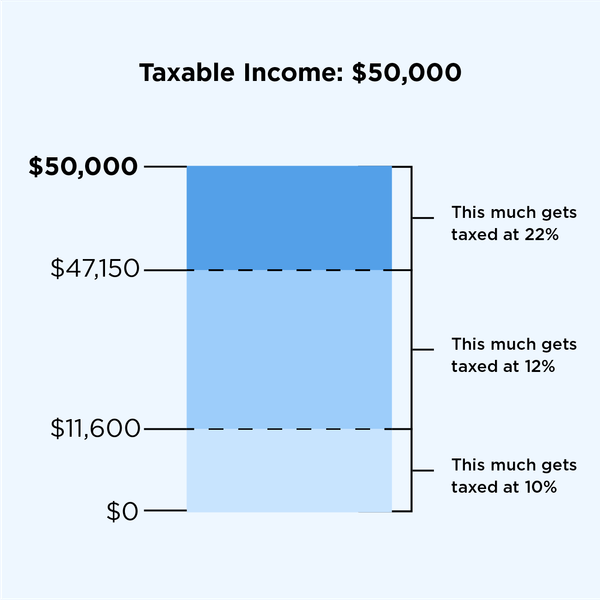2024-2025 Tax Brackets and Federal Income Tax Rates
Federal income tax rates range from from 10% to 37%. Find out how they work and which ones you're in using our tax bracket calculator.
Many, or all, of the products featured on this page are from our advertising partners who compensate us when you take certain actions on our website or click to take an action on their website. However, this does not influence our evaluations. Our opinions are our own. Here is a list of our partners and here's how we make money.
Table of contents
In 2024 and 2025, there are seven federal income tax rates: 10%, 12%, 22%, 24%, 32%, 35%, and 37%. Tax rates will remain the same through the end of 2025 because of the Tax Cuts and Jobs Act (TCJA). Your bracket depends on your taxable income and filing status.
2024 tax brackets
The following brackets and rates apply to income earned in 2024, which is reported on returns due by April 15, 2025, or by October 15, 2025, with a tax extension.
Tax Rate | Single | Married Filing Jointly | Head of Household | Married Filing Separately |
|---|---|---|---|---|
10% | $0 to $11,600 | $0 to $23,200 | $0 to $16,550 | $0 to $11,600 |
12% | $11,601 to $47,150 | $23,201 to $94,300 | $16,551 to $63,100 | $11,601 to $47,150 |
22% | $47,151 to $100,525 | $94,301 to $201,050 | $63,101 to $100,500 | $47,151 to $100,525 |
24% | $100,526 to $191,950 | $201,051 to $383,900 | $100,501 to $191,950 | $100,526 to $191,950 |
32% | $191,951 to $243,725 | $383,901 to $487,450 | $191,951 to $243,700 | $191,951 to $243,725 |
35% | $243,726 to $609,350 | $487,451 to $731,200 | $243,701 to $609,350 | $243,726 to $365,600 |
37% | $609,351 or more | $731,201 or more | $609,351 or more | $365,601 or more |
Source: Internal Revenue Service
Expand each section to view the total taxes owed for each filing status.
Tax bracket calculator
2025 tax brackets
The following brackets and rates apply to income earned in 2025, which will be reported on tax returns filed by April 2026.
Tax Rate | Single | Married Filing Jointly | Head of Household | Married Filing Separately |
|---|---|---|---|---|
10% | $0 to $11,925 | $0 to $23,850 | $0 to $17,000 | $0 to $11,925 |
12% | $11,926 to $48,475 | $23,851 to $96,950 | $17,001 to $64,850 | $11,926 to $48,475 |
22% | $48,476 to $103,350 | $96,951 to $206,700 | $64,851 to $103,350 | $48,476 to $103,350 |
24% | $103,351 to $197,300 | $206,701 to $394,600 | $103,351 to $197,300 | $103,351 to $197,300 |
32% | $197,301 to $250,525 | $394,601 to $501,050 | $197,301 to $250,500 | $197,301 to $250,525 |
35% | $250,526 to $626,350 | $501,051 to $751,600 | $250,501 to $626,350 | $250,526 to $375,800 |
37% | $626,351 or more | $751,601 or more | $626,351 or more | $375,801 or more |
Source: Internal Revenue Service
Expand each section to view the total taxes owed for each filing status.
5.0
NerdWallet rating- Federal: $79 to $139. Free version available for Simple Form 1040 returns only.
- State: $0 to $69 per state.
- Expert help or full service filing is available with an upgrade to Live packages for a fee.
How tax brackets and rates work
1. What are income tax brackets?
The U.S. has a progressive tax system, which means that people with higher incomes are subject to higher federal tax rates, and people with lower incomes are subject to lower income tax rates.
The government decides how much tax you owe by dividing your taxable income into chunks — also known as tax brackets — and each individual chunk gets taxed at a corresponding tax rate. Tax rates can range from 10% to 37%.
The beauty of tax brackets is that no matter which bracket(s) you’re in, you generally won’t pay that tax rate on your entire income. The highest tax rate you pay applies to only a portion of your income.

Federal tax brackets example: If you had $50,000 of taxable income in 2024 as a single filer, you’d pay 10% on that first $11,600 and 12% on the chunk of income between $11,601 and $47,150. Then, you’d pay 22% on the rest because some of your $50,000 of taxable income falls into the 22% tax bracket. The total bill would be about $6,053 — about 12% of your taxable income — even though your highest bracket is 22%. That 12% is your effective tax rate.
2. How do tax brackets and rates work on the state level?
States may handle taxes differently from the federal government. Your state might have different brackets or a different system altogether. Colorado, for example, has a flat tax rate of 4.4% on taxable income, and some states, such as Wyoming, don't have a state income tax. (See state-by-state income tax rates and brackets.)
3. Are income tax brackets adjusted every year?
Yes. All the federal income tax brackets — the window of income where a specific tax rate ends and begins — are updated annually to reflect the current rate of inflation. These tweaks, formally known as inflation adjustments, are a critical part of the tax code.
Bracket adjustments can help prevent taxpayers from ending up in a higher tax bracket as their cost of living rises, a scenario called “bracket creep." They can also lower taxes for those whose compensation has not kept up with inflation.
Tax rate inflation adjustment example
In 2024, a single filer making $48,000 of taxable income pays a 10% tax rate on $11,600 of their earnings, a 12% tax rate on the portion of the earnings between $11,601 and $47,150, and a 22% tax rate on the remaining $850 that falls into that final tax bracket.
Assuming this taxpayer's income does not change in 2025, they will now pay 10% on earnings up to $11,925 and 12% on the rest. In other words, they will no longer pay 22% on any part of their income. This is because the upper end of the 12% tax bracket has been updated from $47,150 to $48,475, which allows this taxpayer to shelter more of their income from a higher tax rate.
What is a marginal tax rate?
The marginal tax rate is the tax rate paid on the last dollar of taxable income. It typically equates to your highest tax bracket. For example, if you're a single filer in 2024 with $35,000 of taxable income, portions of your income would be taxed at 10% and 12%. If your taxable income went up by $1, you would pay 12% on that extra dollar, too.
What is an effective tax rate?
Your effective tax rate is the percentage of your taxable income that you pay in taxes. To determine your effective tax rate, divide your total tax owed (line 24) on Form 1040 by your total taxable income (line 15).
How to reduce taxes owed
Since taxes are paid as you earn, ideally, you are withholding enough tax throughout the year via your W-4 or estimated tax payments to cover what you owe. An overpayment in tax throughout the year will result in a refund, while an underpayment may result in a bill.
Still, two common ways of reducing your tax bill are credits and deductions.
Tax credits can reduce your tax bill on a dollar-for-dollar basis; they don't affect what bracket you're in.
Tax deductions, on the other hand, reduce how much of your income is subject to taxes. Generally, deductions lower your taxable income by the percentage of your highest federal income tax bracket. So, if you fall into the 22% tax bracket, a $1,000 deduction could save you $220.
In other words, take all the tax deductions you can claim. Deductions can reduce your taxable income and could kick you to a lower bracket, which means you pay a lower tax rate.
Tax filing resources
Tax brackets and rates for 2015-2023
Curious how federal income tax brackets and rates have changed over the years? Take a look back.
5.0
NerdWallet rating- Federal: $79 to $139. Free version available for Simple Form 1040 returns only.
- State: $0 to $69 per state.
- Expert help or full service filing is available with an upgrade to Live packages for a fee.



